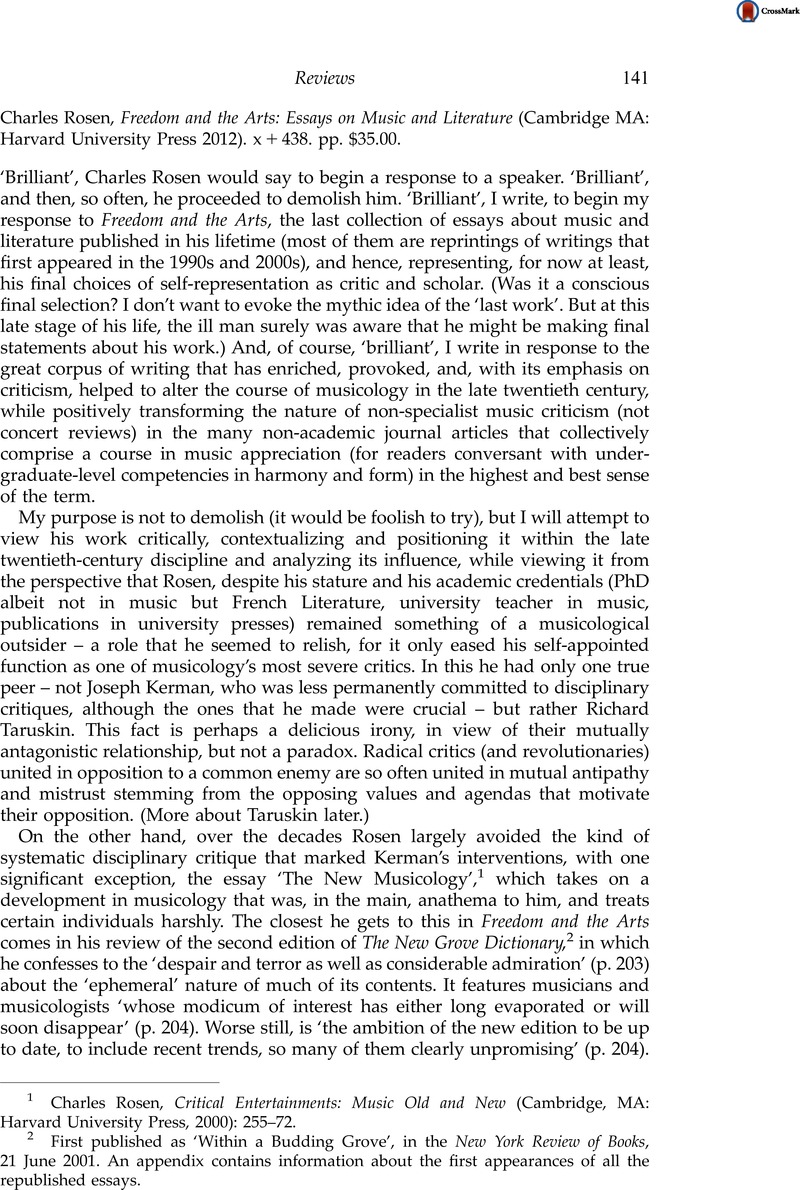No CrossRef data available.
Article contents
Charles Rosen, Freedom and the Arts: Essays on Music and Literature (Cambridge MA: Harvard University Press2012). x + 438. pp. $35.00.
Review products
Published online by Cambridge University Press: 17 June 2015
Abstract

- Type
- Book Reviews
- Information
- Copyright
- Copyright © Cambridge University Press 2015
References
1 Rosen, Charles, Critical Entertainments: Music Old and New (Cambridge, MA: Harvard University Press, 2000): 255–272Google Scholar.
2 First published as ‘Within a Budding Grove’, in the New York Review of Books, 21 June 2001. An appendix contains information about the first appearances of all the republished essays.
3 Freedom and the Arts also contains a discussion (pp. 278–89) of The New Grove Dictionary of Opera and a monograph on the fascination of opera for homosexuals, The Queen's Throat, by Wayne Koestenbaum: ‘Operatic Paradoxes; The Ridiculous and Sublime’. The review of the Grove volume on opera is largely negative; Rosen is particularly annoyed about the lack of attention granted performance. There is no article on singing and nothing that acknowledges the zaniness of opera and opera singers in performance. The book by Koestenbaum gives Rosen a chance to write briefly about the ‘cultural ideology’ of homosexuality as it developed first in the nineteenth century, and to praise Koestenbaum for his focus on the sensual and sexual aspects of operatic works and their performance, from which Grove ‘modestly averts its eyes’ (p. 287).
4 ‘Felix Mendelssohn at 200: Prodigy without Peer’ which includes a mixed review of R. Larry Todd's biography (pp. 171–7), ‘Happy Birthday, Elliott Carter!’(pp. 178–86), ‘Frédéric Chopin, Reactionary and Revolutionary’ (pp. 187–92), ‘Robert Schumann, a Vision of the Future’ (pp. 193–202).
5 Webster, , ‘Mozart's Operas and the Myth of Musical Unity’, Cambridge Opera Journal 2 (1990): 197–218CrossRefGoogle Scholar. Platoff, ‘Myths and Realities about Tonal Planning in Mozart's Operas’, Cambridge Opera Journal 8 (1996): 3–15.
6 ‘Structural Dissonance’ strikes back at James Hepokoski's and Warren Darcy's critique of Rosen on structural dissonance. (See William Drabkin's review of Hepokoski and Darcy's Elements of Sonata Theory in the Musical Times 148: 96). Rosen concludes this essay with a very harsh critique of the analytical vocabulary developed by Hepokoski and Darcy, poking fun at their acronyms concerning form and process and arguing for the unmusical character of their approach to the analysis of form (p. 134).
7 Rosen's opening sentences: ‘In his excellent book on Beethoven's concertos, Professor Leon Plantinga has written that I claim that Leopold Mozart (and, by implication, Wolfgang as well of course) “made use of continuo playing for concertos only at home and only in the absence of winds” [Beethoven's Concertos: History, Style, Performance (New York: W.W. Norton, 1999, p. 367]. In fact, I never denied that Mozart played continuo in public performances of his concertos. I did, however, claim that is was largely inaudible except to members of the orchestra, and I also asserted that […] it was “musically, if not practically, dead”’ (p. 79).
8 ‘Thedoor Adorno: Criticism a Cultural Nostalgia’. The original title of this essay, published in the NYRB in 2002 is revealing; ‘Should we adore Adorno?’.
9 ‘Western Music: The View from California’ (pp. 210–239, originally published as ‘From the Troubadours to Frank Sinatra’ NYRB, February 23 and March 9, 2006.
10 ‘Postscript: Modernism and the Cold War’ (pp. 240–47).
11 Journal of Musicology 26 (2009): 274–84; citation on p. 278–9.
12 That is how he introduces this remark by Taruskin: ‘It was Brahms, in other words, whose music forged the link between Bach and the “Viennese classic” that has since been spuriously read back into the historical narrative, at first by German (“insider”) scholars, and that has quite recently come under intense skeptical scrutiny, chiefly by Americans, the quintessential musicological outsiders’. Cited on p. 227 of Freedom and the Arts.
13 From Parerga und paralipomena (1851); citations from ‘Nicht blutbefleckt’, 277.
14 ‘Nicht blutbefleckt’, 278–9.
15 ‘Nicht blutbefleckt’, 280.
16 New York: Oxford University Press, 2008.
17 The Classical Style (New York: Norton, [1971] 1998.
18 The Romantic Generation (Cambridge MA: Harvard University Press, 1998).
19 Arnold Schoenberg (Chicago: The University of Chicago Press, [1975] 1996). The original edition was Rosen's second book, after The Classical Style, and with the cultural-historical emphasis that was largely missing in the first book, Rosen established the second primary focus for his research and writing. The volume was part of a Viking Press series on ‘Modern Masters’ intended for general audiences, and I bought the paperback edition of this book in 1976 for $2.50. It was a good investment.


